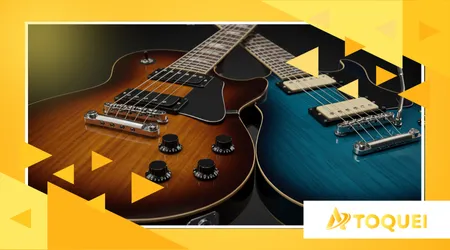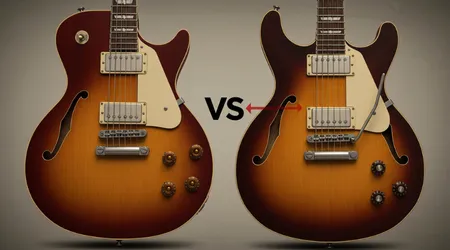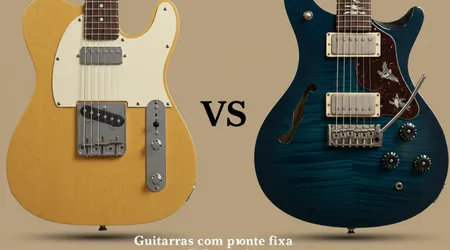Guitars with Fixed or Floating Bridge: Which to Choose

Guitars with fixed or floating bridge define a guitarist's sound and experience, impacting tuning, sustain and versatility.
Advertisements
Choosing between them is not just a technical question, but a decision that reflects style, technique and musical ambition.
In this article, we dive into the characteristics, advantages, and challenges of each bridge type, with insights updated for 2025, practical examples, and a detailed analysis to help beginners and experienced musicians make the right choice.
We'll explore how these bridges shape the instrument's sound, playability, and even maintenance, with a dash of creativity and solid arguments. After all, which bridge will amplify your music?
Choosing the right bridge is more than just an aesthetic preference; it's a commitment to the sound you want to create.
Advertisements
Think of a bridge as the heart of a guitar: it supports the strings, transfers vibrations, and defines how the instrument responds to your playing.
Guitars with fixed or floating bridge offer different paths, each with its own strengths and peculiarities.
This text combines technical information with a practical approach, providing real-life examples, recent statistics, and even an analogy to clarify the topic.
Whether you're a fan of melodic solos or heavy riffs, get ready to understand which bridge maximizes your potential.
What is a Guitar Bridge and Why Does It Matter?
A guitar's bridge anchors the strings and transmits vibrations to the body, shaping the sound. Guitars with fixed or floating bridge differ in mechanics and sound impact.
Fixed bridges, like the Tune-o-Matic, are stable, while floating bridges, like the Floyd Rose, allow for vibrating effects. This choice affects tuning, sustain, and even musical style.
Fixed bridges ensure simplicity and consistency, ideal for genres like blues and classic rock. Floating bridges open doors to expressive techniques but require maintenance.
++ Brazilian Indigenous Aerophones: Types and Cultural Contexts
The choice depends on your goal: stability or versatility? Each bridge plays a unique role in performance.
Why does the bridge matter so much? Because it's the literal and figurative bridge between your technique and the final sound.
A survey of the Guitar World (2024) revealed that 68% of guitarists consider the bridge a decisive factor in their purchase. Choosing the wrong one can limit your musical expression.

Fixed Bridges: Stability and Simplicity
Fixed bridges, like those found on Gibson Les Pauls, are bolted to the body, offering stability. Guitars with fixed or floating bridge differ in maintenance: fixed ones are easier.
They provide long sustain and reliable tuning, perfect for heavy riffs or clean chords.
Blues guitarists like Joe Bonamassa prefer fixed bridges for their direct response. The lack of a lever simplifies adjustments and string changes. It's like a car with a manual transmission: direct and reliable, with no surprises.
On the other hand, fixed bridges limit dynamic effects. Want to make a dive bomb like Steve Vai? Forget it. Rigidity is a double-edged sword: stability, but no flexibility.
See more: How to Avoid Respiratory Fatigue in Long Practice Sessions
Practical example: John, a beginner guitarist, bought an Epiphone SG with a Tune-o-Matic bridge.
He loved the stable tuning for playing AC/DC covers, but missed the expressive vibrato. The choice was ideal for his rock style, but it limited his experimentation.
Furthermore, fixed bridges are economical in the long run. Fewer moving parts mean less wear and tear. Studio guitarists who prioritize consistency often opt for them.
Floating Bridges: Versatility and Expression
Guitars with fixed or floating bridge shine in versatility with floating bridges, like the Floyd Rose. They allow vibrato and dive bombs, ideal for rock and metal. The lever adjusts string tension, creating unique effects.
Eddie Van Halen revolutionized rock with the Floyd Rose, which he used in iconic solos. However, maintenance is complex: tuning requires patience, and string changes are time-consuming. It's like driving a race car: thrilling, but demanding.
Tuning instability is a challenge. Changing one string can throw off the balance of the others. Experienced guitarists, like Synyster Gates, have mastered this learning curve, but beginners can be frustrated.
Practical example: Mariana, a progressive metal fan, chose an Ibanez with a Floyd Rose. Her vibrato solos impressed, but maintenance required her to invest in specialized tools. The versatility was worth the effort.
See also: How to Choose the Ideal Drumhead for the Type of Sound You're Looking for
Floating bridges, like the Bigsby, offer a smooth vibrato, less aggressive than the Floyd Rose. They're common on Gretsch guitars, perfect for rockabilly. Each type of floating bridge has its own personality.
Comparing Features: Which Bridge Aligns Your Style?
Choose between guitars with fixed or floating bridge requires understanding your musical style. The table below compares the two types:
| Feature | Fixed Bridge | Floating Bridge |
|---|---|---|
| Tuning Stability | High | Medium to Low |
| Sustain | Far away | Moderate |
| Versatility | Limited (no lever) | High (vibrato and effects) |
| Maintenance | Simple | Complex |
| Recommended Genres | Blues, Rock, Jazz | Metal, Progressive Rock, Shred |
Fixed bridges are ideal for those seeking simplicity and consistency. Jazz guitarists like Pat Metheny value natural sustain. Floating bridges, on the other hand, attract shredders who want to explore effects.
Think of the bridge as a road: the fixed bridge is a straight, reliable highway; the floating bridge is a winding, yet demanding trail full of possibilities. Which route do you prefer?
The choice also depends on budget. Guitars with Floyd Rose, such as the Ibanez RG, cost more due to their complex mechanics.
Brands like PRS offer simpler floating bridges, like the Wilkinson, balancing cost and functionality.
Consider the context: live performances require stable tuning, favoring fixed bridges. Experimental recordings can shine with floating bridges. What's your stage?
Maintenance and Practice: What to Expect from Each Bridge?
To maintain guitars with fixed or floating bridge requires different care. Fixed bridges require simple adjustments: cleaning, height adjustment, and intonation. String changes are quick, ideal for beginners.
Floating bridges, like the Floyd Rose, require specific tools, such as Allen wrenches. Alternate tunings, like Drop D, can be a nightmare. Patience is essential.
Practical tip: For floating bridges, use a shim to stabilize the bridge during string changes. This saves time and avoids frustration. YouTube tutorials, such as those from 2025, detail the process.
Maintaining floats is intimidating but rewarding. Guitarists like Dimebag Darrell overcame the learning curve, using Floyd Rose for aggressive sounds. The effort is worth it for those seeking expression.
Finally, consider wear and tear. Fixed bridges last longer without repair. Floating bridges, with springs and screws, require frequent maintenance, especially on intense tours.
Trends in 2025: Innovations in Guitar Bridges
In 2025, guitars with fixed or floating bridge keep pace with innovations. Brands like Strandberg introduce fixed bridges with microscopic adjustments, improving intonation. Floating bridges evolve with more precise locking systems.
Hybrid technology is gaining traction. The Evertune bridge, for example, combines fixed stability with floating flexibility. Metalcore guitarists, such as those in the band Architects, are adopting it.
Sustainability is also a trend. Brands like Fender use recycled materials in fixed bridges, maintaining quality. The market reflects the quest for durability and innovation.
Example: Lucas, a studio musician, tested an Evertune in 2025. He praised its impeccable tuning, even over long sessions, but noticed less vibrato than a Floyd Rose.
Artificial intelligence also enters the picture. Apps from 2025 will help calibrate floating bridges, reducing errors. Technology makes things easier, but the choice is still personal.
Which One to Choose? Aligning Bridge with Your Goals
Choose between guitars with fixed or floating bridge It depends on your style and patience. Do you like stability and simplicity? A fixed one is ideal. Are you looking for dramatic effects? Floating is the way to go.
For beginners, fixed bridges are more user-friendly. Experienced guitarists can explore floating bridges, mastering their complexity. Consider the genre: blues and jazz call for fixed bridges; metal and shred, floating bridges.
Rhetorical question: Is your music a straight line or a sonic rollercoaster? The answer guides your choice. Test guitars in stores and feel the difference in practice.
Example: Ana, an indie rock fan, opted for a Fender Telecaster with a fixed bridge. Its simplicity helped her focus on songwriting without technical concerns.
Finally, consider the long term. Fixed bridges are long-term investments; floating bridges require dedication. Align your choice with your musical dreams.

Conclusion: Your Guitar, Your Voice
Guitars with fixed or floating bridge They're more than components; they're extensions of your expression. Fixed bridges offer stability, perfect for straightforward sounds and classic genres.
Floating instruments unleash creativity but require maintenance. The choice reflects who you are as a musician.
In 2025, innovations like Evertune and tuning apps will make the decision more accessible. Whether you're trying out a Gibson with Tune-o-Matic or an Ibanez with Floyd Rose, give it a try.
Your guitar is your voice, choose the bridge that amplifies it.
There's no universal answer. As an analogy, think of the bridge as a real one: a fixed one takes you straight to your destination; a floating one lets you explore exciting detours.
What's your path? Visit stores, research, play. Your music deserves the right bridge.
Frequently Asked Questions
1. Which bridge is best for beginners?
Fixed bridges are easier to tune and maintain, ideal for beginners.
2. Can I install a floating bridge on a guitar with a fixed bridge?
Yes, but it requires modifications to the guitar body and professional adjustments.
3. Do floating bridges always go out of tune?
Not always, but they require precise adjustments. Systems like Floyd Rose minimize this problem.
4. What is the average maintenance cost of a floating bridge?
It varies, but professional adjustments cost between R$100 and R$300 in 2025.
5. Is there a bridge that combines both types?
Yes, Evertune is a hybrid example, offering stability and some flexibility.
